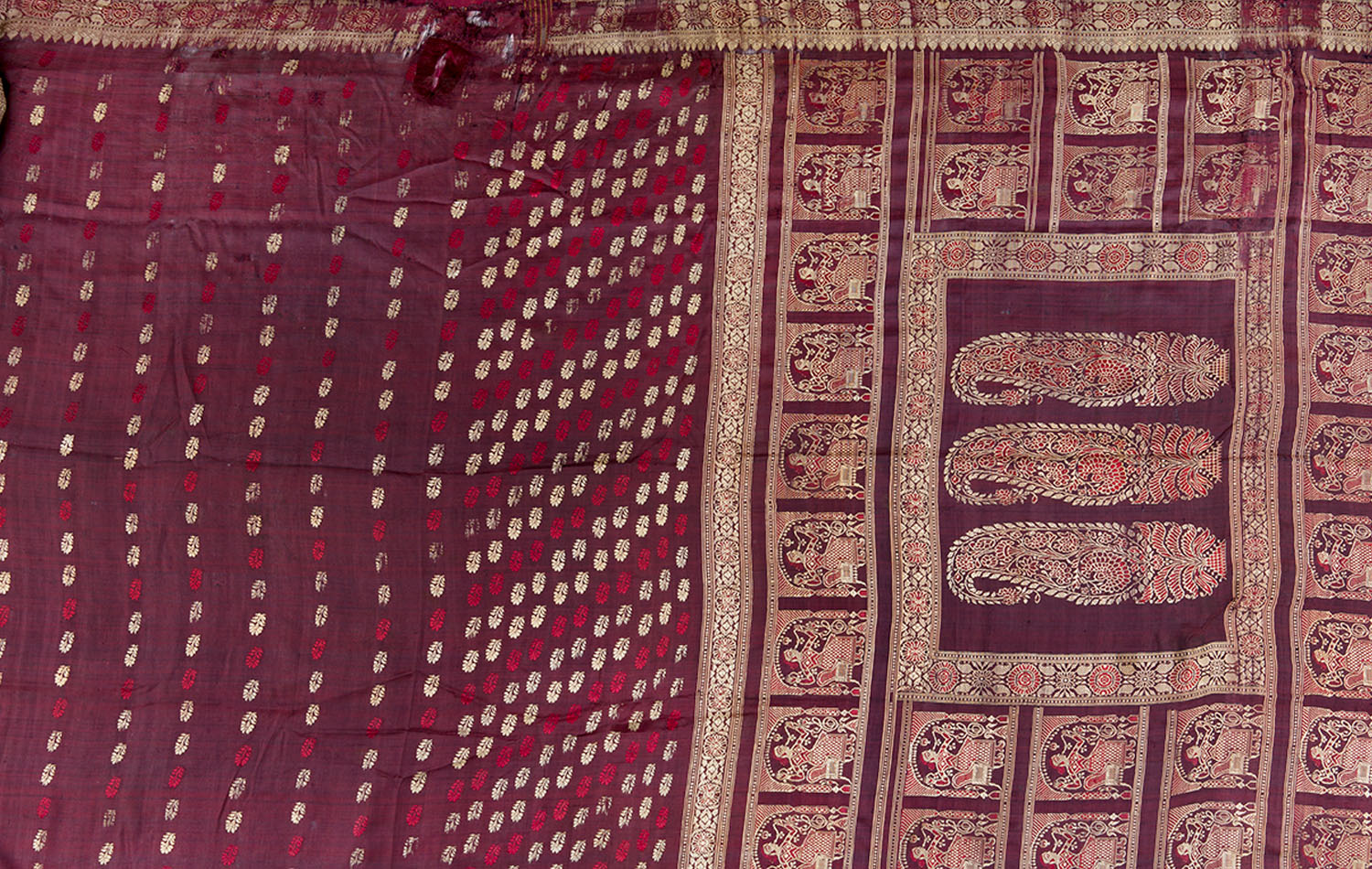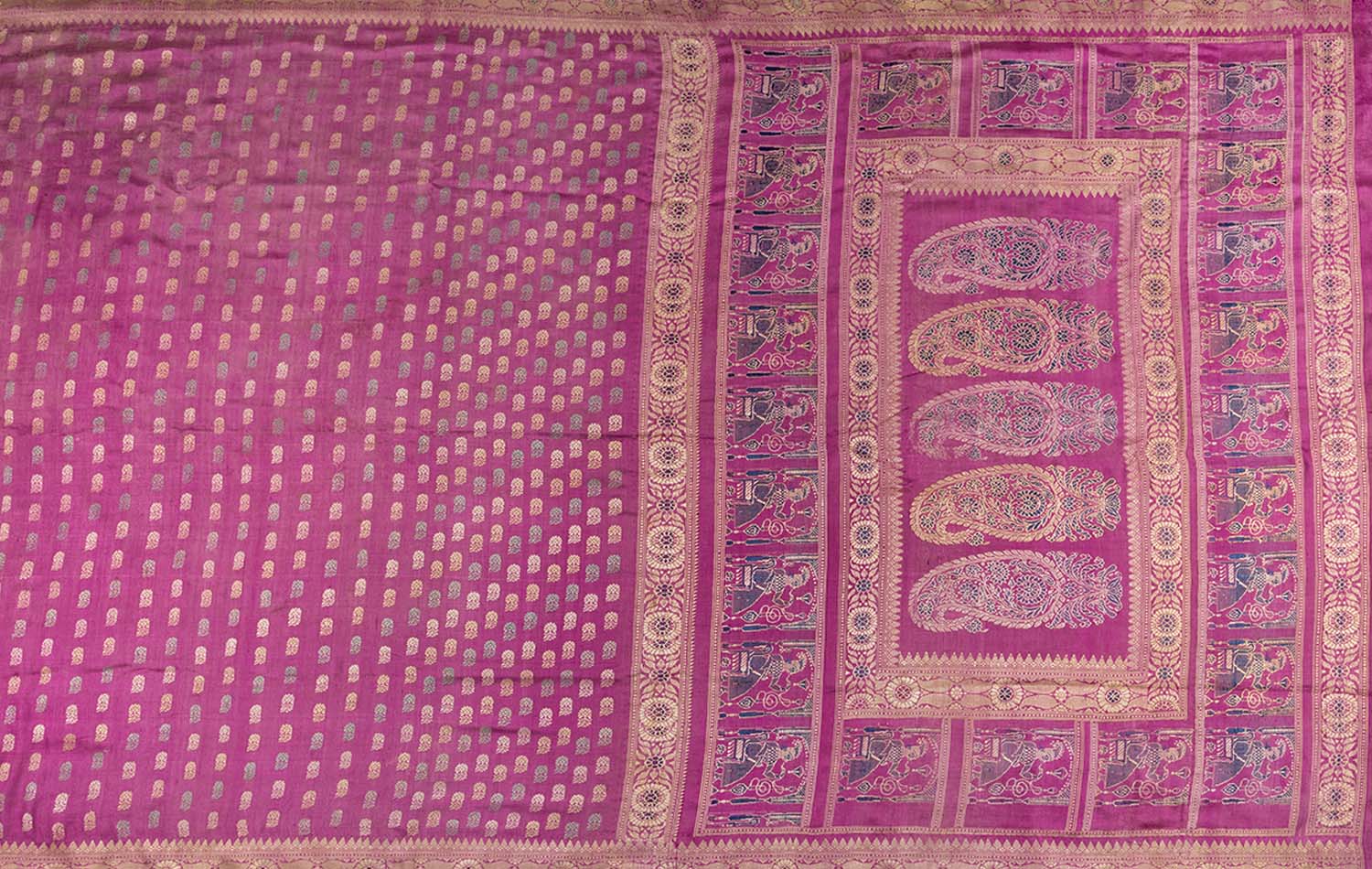ARTICLE
Baluchari Sari
Handwoven using locally grown mulberry silk, tussar or wool in West Bengal, the Baluchari (or Baluchar) sari features elaborate brocade work on the pallu, which depicts scenes from the social life and traditions of the region. They are one of the only saris from South Asia’s late medieval period that prominently feature human figures as motifs. The intricate pictorial depictions are woven almost entirely from silk without the use of zari, distinguishing them from other silk saris and brocade traditions of India. They typically have dark colours such as maroon, deep blue, deep green and purple. The Baluchari sari further stands out among the silk weaving traditions of India for its monochromatic impressions created despite the use of four or five differently coloured pattern wefts in the weaving process.
The production of the Baluchari sari can be traced to Murshidabad, when the Nawab of Bengal, Murshid Quli Khan (1717–27) relocated his kingdom’s capital from Dhaka to Murshidabad and brought a community of weavers who settled in surrounding villages, including Baluchar. In addition to Murshidabad, the saris were also produced in Dhaka and parts of undivided Bengal.
Woven from mulberry silk, a distinctive feature of Baluchari saris is the use of large kairis or paisleys as central motifs on the pallu, which have intricate and broad borders. Historically, these saris were renowned for their depictions of aristocratic men and women smoking hookahs, Nawabs reclining on bolsters, European officers in conversation and modes of transport such as trains and steamboats. While earlier Baluchari saris depicted social scenes from the Nawabi court, representations of Company officials and other Europeans became increasingly common after the Battle of Plassey in 1757.
The motifs are first drawn on graph paper, then punched into cards used in a jacquard loom, making it simpler to transfer the designs onto the saris. The sari is woven with its reverse side facing up, and the karigar uses a mirror to be able to see the weaving. Although similar to Gujarati and Benaras brocades, Baluchari saris are distinguished by the numerous human and animal motifs interspersed between jaalis and floral vine borders, creating a homogenous design throughout the garment. The motifs face inwards from the borders of the sari and culminate in a central pictorial depiction on the pallu, which is sometimes almost two metres long, indicating that it may have been created to be draped over the shoulder to cover the upper body, similar to the Gujarati drape.
The production of Baluchari saris peaked between the second half of the eighteenth century and the first half of the nineteenth century — a period during which undivided Bengal was annexed by the British East India Company. In the latter half of the nineteenth century, due to frequent flooding in Murshidabad, production moved to other parts of the town and further south to Bishnupur. The weavers soon began using tussar silk and motifs inspired by the architecture of Bishnupur temples and Islamic ornamentation, thus capturing and narrating the changing scenario of colonial Bengal, specifically Murshidabad.
Low demand due to competition from inexpensive alternatives and the increasingly popular Benaras brocade hampered the production of Baluchari saris in the twentieth century. There have since been numerous attempts to revive the tradition by introducing weavers to the jacquard loom as well as the Benarasi jala to help preserve motifs and encourage intricate weaving. In 2009, Baluchari saris received a Geographical Indication (GI) status from the Government of India for their territory-specific production and characteristics, authenticating only those saris manufactured in Bankura district as genuine.
Bibliography
Our website is currently undergoing maintenance and re-design, due to which we have had to take down some of our bibliographies. While these will be re-published shortly, you can request references for specific articles by writing to hellomapacademy@map-india.org.








